| 267
|
CHAPTER 43
Disabled Gangsters Help a Child
with Muscular Dystrophy
Creating an Environment That Brings Unexpected Improvement in
Children with Muscular Dystrophy

Muscular dystrophy is a condition in which muscles gradually become
weaker and weaker. Most specialists agree that nothing can be done to help
the child regain lost strength. This may be true in the long run. But we
have seen some children seem to get stronger, at least for a limited time.
ABEL, for example, is a boy with Duchenne's muscular
dystrophy. His arms had grown so weak that he could not push his
wheelchair more than a few inches on a flat surface. His parents wheeled
him everywhere. While at PROJIMO, Abel gradually regained enough strength
to wheel himself around the whole yard. In doing so, he gained a new sense
of self-determination.
Over a period of 3 years, as his dystrophy slowly progressed, Abel
again lost his capacity to propel his wheelchair. But for years he had
achieved greater independence of movement - an ability which he, his
parents, and his doctors had assumed was permanently lost.
Although a child with muscular dystrophy has slowly diminishing
muscular potential, it appears that, at any stage of his
condition, his strength and physical ability can be increased to more
closely approach his potential at that stage.
Abel's increase in strength and ability at PROJIMO was probably the
result of several factors: increased activity,
increased motivation, and increased
expectation by others. At home, his parents had done
everything for him. They had kept him away from activities and adventures
they feared might tire him. But at PROJIMO, Abel was encouraged to do as
much as he could for himself. Also, he had excellent role models,
including persons who were quadriplegic (paralyzed from the shoulders
down), yet who were largely independent in self-care.
Creating an environment that brings unexpected improvement - in
gangsters.
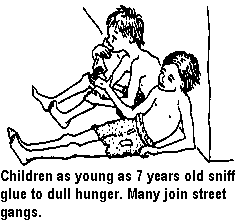
There is an old saying: "Poor Mexico, so far from God and so close to
the United States!" Mexico's huge foreign debt, falling wages, growing
unemployment, and pressure from the US to weaken Mexican laws protecting
small farmers have all increased the hardships for most Mexicans.
Since the start of the North American Free Trade Agreement (NAFTA) in
1994, over 2 million peasants have been forced off their land to join the
jobless multitudes in Mexico's swelling city slums. As the gap widens
between rich and poor, millions of street children and youth struggle to
survive through odd jobs, stealing, prostitution, and drug trafficking.
Crime rates, violence, and police brutality have drastically increased.
This growing "sub-culture of violence" has brought new difficulties and
challenges to PROJIMO. The small village program has had to attend to over
400 spinal-cord injured youths, mostly disabled by bullet wounds, from all
over Mexico. |
| 268
|
| Dilemma for PROJIMO. When
these newly disabled street-youths and gangsters arrive at PROJIMO, most
are angry and depressed. Many have been heavy users of alcohol and
drugs. Becoming physically disabled does not automatically end their
habits of violence, crime, and drugs. PROJIMO has, within the program,
had to deal with acts of violence, armed assault, drug trafficking and
use, drunkenness, attempted rape, and attempted murder. The team has
sought new ways to deal with the complex needs of young men and women
(mostly men) who are both physically and psycho-socially disabled. It
has not been easy. PROJIMO has set rules of behavior prohibiting
alcohol, drugs, and violence within its grounds. Those who break the
rules are threatened with expulsion. But it is not easy to throw
out someone who has dangerous pressure sores or other life-threatening
problems. Many have no home to return to. To send them back to
the city streets can be a death sentence. One young quadriplegic man who
was expelled from PROJIMO died from pressure sores 3 months later.
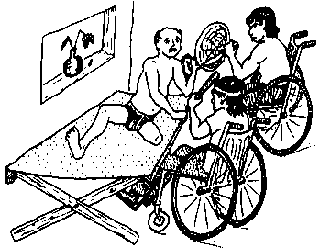
One of the worst acts of violence at PROJIMO was when two young men,
who had been shot through the spine in gang fights, got high on drugs
and booze. They attacked a retired, diabetic school teacher who was
being fitted for an artificial leg. They tried to stab him as he lay on
his bed. The terrified teacher shielded himself with an electric fan
until help arrived.
To cope with this problem, PROJIMO sought help from an
Alcoholics-and-Drugs-Anonymous program run by recovering addicts in the
city of Guadalajara. On his return to PROJIMO, one of these two young
offenders became a peer counselor for other young people hooked on
drugs. He helped a lot of youths get control of their lives before he
himself had a relapse, again became violent, and voluntarily left
PROJIMO.
What has been wonderful, however, has been the
apparent transformation within several of these young gangsters and
drug-dealers during their stay at PROJIMO. Some of the young
men, who seemed the most mean-spirited and aggressive when they came,
have become among the most helpful and caring members of the PROJIMO
team. In this book's Introduction (on
page 3) we mentioned Quique, who was so
supportive with José, a mentally handicapped little boy whom no one else
was able to reach. Another example is Martín Pérez, who became one of
PROJIMO's most gifted wheelchair and gurney designers (see Chapters
37 and 39).
Martín showed heart-felt concern for those difficult children whose
behavior sometimes led attendants to dislike or neglect them. When
Martín, like Quique, was finally thrown out of PROJIMO for repeated drug
use; one young girl, Tere, wept. "Martín was always the first to help me
if my wheelchair broke, or when I needed somebody to talk to who really
listened and cared," she said.
Seeing this kind of change from angry hoodlum to tender care-provider
or creative craftsperson has given many of us more insight into human
nature. It seems true that inside every person, however brutish
their exterior, there is a hidden seed of goodness, a seed of
compassion waiting for a chance to grow and flower. The longer that core
remains dormant and unrealized, the more urgent is its need for
fulfillment. Sometimes all it takes to start that seed sprouting is a
friendly word, an expectation of good will, a recognition that the
person has worth ... or a request for help when it is sorely needed.
With the right word or touch, the toughest thug may suddenly shed his
hard shell and offer heart-warming assistance and concern. And in the
process, he discovers joy in doing something loving and lovable. |
| 269
|
Angel - a Six-Year-Old Boy with Muscular Dystrophy
ANGEL was brought to PROJIMO by his mother from the
village of San Augustine, 40 kilometers away. Mari and Conchita did
their best to get the boy to relax and to win his trust. They talked to
him in a friendly way and offered him toys to play with. But Angel clung
fearfully to his mother and would burst into tears when asked a question
or when gently touched.
Angel's mother said the boy had difficulty walking and that his
condition was getting worse. She said she had taken him to doctors in
the city, who had prescribed everything from painkillers (although he
had no pain) to vitamins, calcium, hormones, and injectable antibiotics.
But his walking kept getting worse.
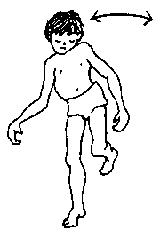
Mari and Conchita asked Angel's mother to walk across the room. She
did so, and Angel followed her. He had a waddling gait, throwing his
weight from side to side, a sign of weakness at the sides of the hips.
His calf muscles were unusually large for his thin body, and he walked
slightly on tip-toe. He had trouble lifting his arms over his head. In
order to stand up from the floor, he climbed up his body using his arms.
Although there was apparently no famify history (no relatives with a
similar condition), Mari recognized Angel's gradually increasing muscle
weakness as typical of Duchenne's muscular dystrophy.
Conchita was also concerned about Angel's emotional and social
development. He was very insecure and fearful of strangers. His mother
explained that he was not used to strangers. He did not go to school,
she said, because other children teased him and said he "walked like a
goose." (This made me recall how I was teased as a child, see
page 83.)
Possible Actions: The PROJIMO team gently
explained to Angel's mother that muscular dystrophy is a condition in
which the boy's muscles gradually get weaker. To date, no medical cure
has been found. But they helped her to realize that certain things could
be done to help her son live a fuller, happier life.
They also discussed with her different forms of "therapy." They
stressed that therapy - if used at all - should be approached in ways
that help, rather than block, the child's social, emotional, and mental
development. They told her about the exciting and rewarding life of the
Peraza family, in which 4 children with muscular dystrophy became
leaders and teachers in a program for disabled children (see
Chapter 48).
Mari also told Angel's mother something about experimental
alternatives, including intensive "massage therapy." The PROJIMO team
had learned about this from a visiting massage therapist, Marybetts
Sinclair. Although they could not promise improvement and the therapy
was described as controversial, Angel's mother was eager to try it.
Because Marybetts would be visiting again in a few weeks, they invited
Angel and his mother to return at that time.
Innovative management of muscular dystrophy: massage
therapy combined with physical therapy. The controversial new
treatment for muscular dystrophy mentioned above has been promoted by a
self-made therapist named Meir Schneider, who now practices in San
Francisco, California. Schneider claims that an intensive program of
massage therapy can halt the progression of muscular dystrophy and help
to return lost muscle strength. Although many medical professionals are
skeptical of Schneider's claims, Marybetts Sinclair, the massage
therapist who occasionally volunteers at PROJIMO, has shown the team
documents and films supporting his approach. Everyone agreed that
perhaps it was worth a try. |
| 270
|
| Working and playing with Angel.
Angel and his mother returned to PROJIMO as agreed. A physical therapist
from Australia who was then volunteering at PROJIMO was skeptical about
Schneider's methodology. Additionally, he insisted there was "no way"
that such an intensive massage program could be applied to a child as
fretful and uncooperative as Angel. Everyone agreed that any
attempt at therapy would need to be approached slowly and gently, as
much as possible in the form of play, while trying to gradually win
Angel's confidence and trust. A flexible schedule was
developed combining therapeutic massage and physical therapy.
They began with brief sessions and planned to gradually build up to
several hours a day. The challenge was to make the experimental approach
interesting, varied, and fun enough for Angel to accept and enjoy it.
Sessions of massage followed by exercise games
were followed with play on the swings, rocking horses, and other
equipment on the outdoor Playground for All Children. To
encourage interaction with a variety of people (and to divide up the
work), nearly a dozen disabled and non-disabled persons were recruited
to help.
The therapeutic massage, in keeping with Schneider's recommendations,
consisted of gentle circular motions with the finger-tips over the whole
body, concentrating on the most important and affected muscles. At first
- as predicted - the boy was fearful of being touched by anyone but his
mother. But his helpers were gentle and his mother also took part. The
massage was so soothing that the boy gradually relaxed and began to
enjoy it. By the third day he was eager for more.
Exercise activities, mostly through play, were
combined with and followed the massage. These were designed to encourage
a full range of motion, as much as possible through
active muscle use, yet without causing fatigue. Simple
games were devised, inviting the boy to touch or hit another person's
hand or to kick a ball with his outstretched foot. Each time, he was
encouraged to stretch a little farther or reach a little higher. He
would proudly count how many times he could repeat each action. (Thus,
his counting skills increased along with his physical skills.)
Gangsters as therapists.
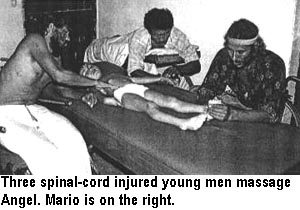
Although at first many persons at PROJIMO assisted with Angel's
therapy, after a few days fewer people arrived to take part. Among those
who showed greatest persistence and concern were some of the "gangsters"
and street youth who had been disabled in gun fights. Day after day,
three paraplegic young men would circle the couch on which Angel lay,
gently providing massage and playful exercise. Angel gradually grew
comfortable with them, laughing with delight at the games.
These young men clearly took pride and joy in helping little Angel,
and in seeing him respond so enthusiastically to their efforts. It was
good therapy for everyone. |
| 271
|
| The gentle side of a tough guy.
One of the spinal-cord injured young men who showed the most care and
innovativeness in working and playing with Angel was Mario. Perhaps
Mario missed his own childhood (which he had never really had). Or
perhaps he missed his only child, who had died. In any case, Mario
sympathized with Angel's fragile vulnerability. MARIO
had grown up as a street child and, since boyhood, had trafficked in and
used drugs. In his 20s he decided to turn over a new leaf. He married
and settled down on a ranch. But old gang rivalry caught up with him in
the form of a drive-by shooting. The same bullet which left Mario
paraplegic passed through his baby daughter in his arms. Weeks later, in
revenge, his brothers captured the culprits. From his wheelchair, Mario
watched as his bothers tortured them to death.
In retrospect, Mario does not try to justify this action, but sadly
explains: "They killed my baby."
For all that, Mario has a gentle side, a depth of caring that is
sometimes born of pain. At PROJIMO, where he stayed for a long time
while his deep pressure sores gradually healed, Mario learned carpentry
skills and began to help in the wood-working shop.
In time, Mario became a skilled craftsperson, making special seating
and personalized equipment for children with special needs. He was quite
creative. But the main reason that his innovations often turned out well
was because he worked so closely with the child and his parents.
Children liked him because he listened to them and related to them on
their terms. He no longer had interest in maintaining the macho (manly)
distance and toughness so typical of grown-up males. He'd had enough of
all that.
With Angel, Mario was both imaginative and creative - and playful in
a non-threatening way. He was constantly coming up with new ideas to
turn Angel's therapy into games. Angel loved it, and became very
attached to Mario.
Here are some of the ideas that Mario and his co-workers came up with
to motivate Angel and to turn his therapy into play.
The leaf-on-a-stick balancing act, to improve gait.

Although part of Angel's side-to-side pendulum-like gait was due to
reduced muscle strength at the sides of his hips, the weakness and
outward (varus) collapse of his ankles also was a factor. After Raymundo
custom-fitted him with light-weight plastic ankle-braces (AFOs, see
page 86), his gait improved. When
prompted, Angel could walk without lurching as much from side to side.
But, partly due to habit, he would quickly fall back into the old wobbly
pattern.
To help him learn to walk without lurching so much from side to side,
Mario invented a simple game.
Angel would hold a thin pole upright with a mango leaf bent over its
tip. The boy would then try to walk across the room without the leaf
falling. To do this, he had to walk smoothly, keep his body steady, and
not lurch sideways. When he succeeded (as he did more and more often)
everyone clapped. After a few days, Angel's gait showed noticeable
improvement, even when he was not playing the game. He also held his
head higher. |
| 272
|
The truck-under-the-bridge game - to exercise the belly and
back.

To help him use his stomach and back muscles, the PROJIMO team asked
Angel to lie first on his belly, then on his back, and arch his body
upwards. To turn this into a game, Mario asked a group of school
children in the toy shop to make a toy truck loaded with brightly
colored blocks of different heights.
Angel at once fell in love with the truck ... and the exercises that
came with it. As Angel lay on his back, Mario or another one of the
therapy helpers would drive the truck in circles around Angel. They
would toot loudly as the truck approached his mid-section. At the toot,
Angel would arch his body upwards to let the truck pass under the
"bridge" formed by his body. When this game began, Mario started with
shorter blocks so that Angel would not have to lift very high. But as
his ability to lift his body increased, Angel helped Mario to load the
truck with taller blocks. This gave the boy more of a challenge. Angel
enjoyed the game and did his best to "lift the bridge" for the tallest
truck-load of blocks.
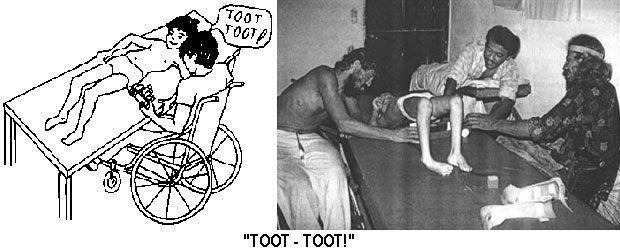
|
| 273
|
RESULTS:
On evaluating the therapeutic activities that were used with
Angel, it is important to consider their effect on the whole child -
physically, emotionally, and socially - not just the specific objectives
that the activities were designed to meet.
Physically, the combination of Angel's massage
therapy, exercise, and increased activity appeared to have a
limited but positive effect. During two weeks at PROJIMO, the
boy's gait improved visibly. There were also gains in his capacity to do
things that involve lifting and moving different parts of his body.
After Angel returned to his home, his mother continued with the
massage and exercise games. When Angel came back to PROJIMO 3 months
later, many people commented that his walking had improved even more.
We still do not know the long-term outcome. Despite apparent
short-term improvements, we can not presume that progressive muscle loss
has been reversed or halted. Rather, we suspect that the plentiful
stimulation and modest (non-fatiguing) use of under-used muscles helped
put his body in more optimal condition, within its given stage of
deterioration. It stands to reason that, as the dystrophy advances,
reduced activity will add to the degenerative process. By contrast,
keeping the body in its best possible physical shape may slow muscle
loss and bring at least temporary improvement in body function.
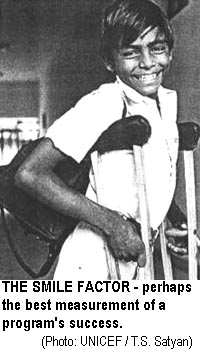
Emotionally and socially, Angel improved enormously.
During his stay at PROJIMO, he changed from a whiny, clinging little boy
who feared everyone but his mother, into a playful child who enjoyed the
closeness and attention of other people.
Angel's physical condition will probably continue to deteriorate,
possibly more slowly than it might have otherwise. But his mind and
spirit will continue to develop - perhaps more openly, fully, and
happily than they might have without the warm, friendly touch of folks
like Mario at PROJIMO.

In the last analysis, perhaps the best indicator of an activity's
success is the smile factor. Certainly, Angel smiles
more than he used to!
___________________________
WARNING: Though the boy in this photo is smiling
now, his poorly adjusted crutches may cause more disability later. With
his elbows so bent, he cannot support his weight on his hands, and so he
supports himself under his arm-pits. This can damage nerves and
gradually paralyze his hands. See the suggestions on pages
12 and 117
... THE SMILE MUST NOT BE THE ONLY MEASURE OF SUCCESS. |
| 274
|
|
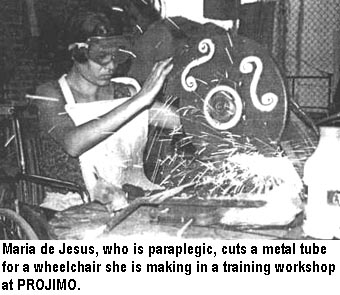

|
|